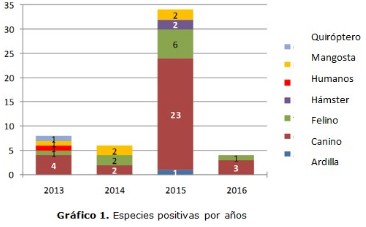Behavior of rabies outbreaks in Havana province
Keywords:
Palabras claves, focos rábicos, Rabia, comportamiento, La Habana.Abstract
Background: for the public health and world development diseases such as Dengue, Zika, Chikungunya, Yellow fever and rabies are re-emergent and most of them are infections that have crossed the barrier that exists between animal species and humans.
Objective: to analyze the behavior of rabies outbreaks in Havana province, from 2013 to 2016.
Methods: a retrospective descriptive, observational study of rabies-positive animal species examined at the Provincial Center for Hygiene, Epidemiology and Microbiology of Havana was conducted from 2013 to 2016. 51 samples of brains from carnivores, bats, and herbivores studied in the province were included. The direct immunofluorescence technique was used for the diagnosis of rabies. The description of the positivity was carried out using the Excel information systems.
Results: the municipality of Boyeros with the highest positivity index (24.5%) followed by Arroyo Naranjo, displaces canine rabies with 61.7% of rabies cases by mongoose. (Specify other relevant results).
Conclusions: the largest report of cases was reported in Boyeros geographically located in the south Havana province and bordering with Artemisa province.
DeCS: RABIES/epidemiology; RABIES VIRUS; BEHAVIOR, ANIMAL; ZOONOSES; EPIDEMIOLOGY, DESCRIPTIVE.
Downloads
References
1.Cohen Ml. Resurgent and emergent disease in a changing world. BR Med Bull. 1998;54(3):523-32.
2.García González G, Diéguez Fernández L, Aldana Arias F, Alonso Bravo L. Bioecología y estrategias de control de la mangosta (Herpestesauropunctatusauropunctatus). Importante reservorio de La Rabia en Cuba. Arch Med Camagüey [Internet]. 2006 [citado 12 Abr 2017];10(1):[aprox. 12 p.]. Disponible en: http://www.amc.sld.cu/amc/2006/v10n1-2006/1058.pdf
3.Organización Panamericana de la Salud, Organización Mundial de la Salud. La rabia completamente prevenible. Boletín al día [Internet]. 12 Jun 2015 [citado 12 Abr 2017]:[aprox. 9 p.]. Disponible en: http://boletinaldia.sld.cu/aldia/2015/06/15/rabia/.
4.Arredondo Bruce A, Amores Carraté J. Enfermedades Reemergentes: Factores causales y vigilancia. Arch Med Camagüey [Internet]. 2009 [citado 12 Abr 2017];13(2):[aprox. 10 p.]. Disponible en: http://www.amc.sld.cu/amc/2009/Vol13n2/pdf/amc160209.pdf
5.Centros para el Control y la Prevención de Enfermedades [Internet]. Atlanta: CDC [actualizado 2 Nov 2010; citado 12 Abr 2017]. La rabia en los EE. UU. y en el mundo; [aprox. 2 pantallas]. Disponible en: https://www.cdc.gov/rabies/es/localizacion/index.html
6.Alemán Brunet MC, Guerra Rodríguez Y, Rodríguez Heredia O, Castañeda Souza A. Intervención educativa para elevar el nivel de conocimientos sobre rabia en adolescentes. Arch Med Camagüey [Internet]. Feb 2012 [citado 3 Abr 2017];16(1):[aprox. 9 p.]. Disponible en: http://scielo.sld.cu/scielo.php?script=sci_arttext&pid=S1025-02552012000100008&lng=es
7.Dean DJ, Abelseth MK, Atanasiu P. The fluorescent antibody test. En: Meslin FX, Kaplan MM, Koprowski H, editors. Laboratory techniques in rabies. 4th ed. Geneva: World Health Organization; 1996. p. 88-95.
8.Granma [Internet]. La Habana: Granma; 9 Ago 2017 [citado 3 Mar 2017]. Cruz de la Paz R. La Rabia; [aprox. 3 pantallas]. Disponible en: http://www.granma.cubaweb.cu/salud/consultas/r/c01.html
9.Navarro Vela AM, Bustamante NJ, Sato SA. Situación actual y control de la Rabia en Perú. Rev perú med exp salud publica [Internet]. 2007 [citado 12 Abr 2017];24(1):[aprox. 5 p.]. Disponible en: http://www.scielo.org.pe/scielo.php?script=sci_arttext&pid=S1726-46342007000100008&lng=es&nrm=iso&tlng=es
10.Cediel Becerra NM. Asociación entre la epidemiología de la rabia canina, la organización del programa de rabia y las condiciones socio-económicas en Colombia. Estudio ecológico [tesis]. Bogotá: Universidad Nacional de Colombia; 2007 [citado 3 Mar 2017]. Disponible en: http://www.bdigital.unal.edu.co/652/1/597576.2007.pdf
11.Barrett CB, Travis AJ, Dasgupta P. On biodiversity conservation and poverty Traps. PNAS [Internet]. 2011 Ago [citado 2017 Abr 17];108(34):[aprox. 6 p.]. Available from: http://www.pnas.org/content/108/34/13907.short
12. Brito Hoyos DM, Brito Sierra E, Villalobo Álvarez R. Distribución geográfica del riesgo de Rabia de origen silvestre y evaluación de los factores asociados con su incidencia en Colombia, 1982–2010. Rev Panam Salud Pública [Internet]. 2013 [citado 17 Abr 2017];33(1):[aprox. 7 p.]. Disponible en: http://iris.paho.org/xmlui/bitstream/handle/123456789/9227/a02v33n1.pdf?sequence=1&isAllowed=y
13.Cuba. Ministerio De Salud Pública. Programa Nacional de Prevención y Control de la Rabia [Internet]. La Habana: Minsap; 1997 [citado 17 Abr 2017]. Disponible en: http://aps.sld.cu/e/prorabia.html
14.Belotto AJ. Rabia Silvestre en las Américas. En: Simposio Internacional de Salud Pública (Inocuidad de alimentos, zoonosis y fiebre aftosa), Protección Sanitaria y Desarrollo agropecuario [Internet]. Bogotá, Colombia: Ica–Ops; 2002 Jun 11-14 [citado 17 Abr 2017]. Disponible en: http://www.paho.org/cdmedia/hdmvp01/docs.rabia/nuevos/rabia%20silvestre-%20belotto.pdf
15.Schneider MC, Romijn PC, Uieda W, Tamayo H, Silva DF Da, Belotto A, et al. Rabies Transmitted by vampire bats to humans: An emerging zoonotic disease in Latin America? Rev Panam Salud Publica [Internet]. 2009 Mar [citado 2017 Abr 19];25(3):[about 9 p.]. Available from: http://www.scielosp.org/scielo.php?script=sci_arttext&pid=S1020-49892009000300010&lng=en
16.Russell CA, Smith Dl, Childs JE, Real LA. Predictive Spatial Dynamics and Strategic planning for raccoon rabies emergence in Ohio. Plos Biol [Internet]. 2005 [citado 2017 Apr 19];3(3):[about 7 p.]. Available from: http://journals.plos.org/plosbiology/article?id=10.1371/journal.pbio.0030088

Published
How to Cite
Issue
Section
License
Copyright: Camagüey Medical Archive Magazine, offers immediately after being indexed in the SciELO Project; Open access to the full text of the articles under the principle of making available and free the research to promote the exchange of global knowledge and contribute to a greater extension, publication, evaluation and extensive use of the articles that can be used without purpose As long as reference is made to the primary source.
Conflicts of interest: authors must declare in a mandatory manner the presence or not of conflicts of interest in relation to the investigation presented.
(Download Statement of potential conflicts of interest)
The Revista Archivo Médico de Camagüey is under a License Creative Commons Attribution-Noncommercial-No Derivative Works 4.0 International (CC BY 4.0).
This license allows others to distribute, to mix, to adjust and to build from its work, even for commercial purposes, as long as it is recognized the authorship of the original creation. This is the most helpful license offered. Recommended for maximum dissemination and use of licensed materials. The full license can be found at: https://creativecommons.org/licenses/












 22 julio 2025
22 julio 2025